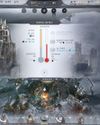How parallel processing is key to AI learning to drive

The day looms closer when autonomous vehicles will be let loose on our roads, as the legal implications, safety concerns, and technical considerations get ironed out. Movement on the last of those has been swift, with progress from companies such as Google, Tesla, General Motors, and MIT’s Computer Science and Artificial Intelligence Laboratory. Some vehicles, though, are powered by a name familiar to anyone who’s played a game on PC in the past 20 years.
Nvidia’s entry into the autonomous vehicle market might seem to be an odd choice for a company more commonly associated with texture fill rates and polygons-per-second, but it’s the massive parallelism of its processors, as well as their relatively low power requirements, that makes them suitable.
Autonomous vehicle technology is divided into levels, with Level One being something as simple as cruise control, and Level Two taking that a step further with automatic parking or adaptive cruise control that stays a set distance from the car in front. Level Five is a fully robotic car that may not even have a steering wheel, and which can drive itself in areas that don’t have hyperdetailed mapping or any kind of geofencing to help it out. Cars currently available are around Level Two, with anything higher being the domain of Tesla, high-end Audi, or Mercedes, and those used purely for testing.
Esta historia es de la edición December 2018 de PC Gamer US Edition.
Comience su prueba gratuita de Magzter GOLD de 7 días para acceder a miles de historias premium seleccionadas y a más de 9,000 revistas y periódicos.
Ya eres suscriptor ? Conectar
Esta historia es de la edición December 2018 de PC Gamer US Edition.
Comience su prueba gratuita de Magzter GOLD de 7 días para acceder a miles de historias premium seleccionadas y a más de 9,000 revistas y periódicos.
Ya eres suscriptor? Conectar

"The War Within itself has kept me coming back most evenings too"
WORLD OF WARCRAFT remains my jailer, and I couldn't be more pleased about it

OK BUILDER
SATISFACTORY is the new titan in building and crafting games

HELL YES
DIABLO IV: VESSEL OF HATRED is a transformative expansion

MOUSE: PI FOR HIRE
This mouse wants to be more than just a gimmick

WINDBLOWN
Dead Cells dev's new roguelike has me afraid for my free time

NO MORE ROOM IN HELL 2
As the zombie horde surrounded me just moments after taking down my two remaining teammates, the writing was really on the wall. Armed with just a chef's knife, it was clear I stood no chance, but I was going down swinging, hoping for a miracle... it didn't come.

OWNED BY STEAM
VALVE cordially reminds you that your games aren't yours

CURSE OF THE AZURE BONDS
These classic games haven't aged badly, but I sure have.

DEEP FREEZE
Endure a blizzard of tough choices and rough consequences in FROSTPUNK 2

NEW HORIZONS
Building up REMNANT 2 outside the live service game grinder